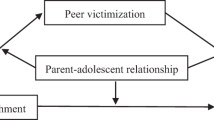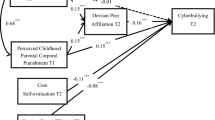Abstract
This study examined the mediating effect of cognitive impulsivity and the moderating effect of dispositional mindfulness in the relations between peer victimization and adolescent proactive and reactive aggressive behaviors. The sample included 2477 Chinese adolescents (51.43% boys and 48.57% girls; Mage =12.23 years, SD = 1.65). The results of path analysis showed that peer victimization was significantly related to both proactive and reactive aggressive behaviors. Cognitive impulsivity mediated in the relations between peer victimization and proactive and reactive aggressive behaviors. Dispositional mindfulness buffered against the relations between peer victimization and proactive aggressive behavior, and between peer victimization and cognitive impulsivity. The results further showed that the indirect effect of cognitive impulsivity was more salient when there were lower levels of dispositional mindfulness. This study revealed the mediating and moderating mechanism between peer victimization and aggressive behavior from the perspective of the control model of the criminal lifestyle theory and has important implications for preventing and reducing adolescent aggressive behaviors.



Similar content being viewed by others
Data availability
The datasets generated and/or analyzed during the current study are not publicly available but are available from the corresponding author on reasonable request.
References
Bergin, A. J., & Pakenham, K. I. (2016). The stress-buffering role of mindfulness in the relationship between perceived stress and psychological adjustment. Mindfulness, 7, 928–939.
Bishop, S. R., Lau, M., Shapiro, S., Carlson, L., Anderson, N. D., Carmody, J., et al. (2004). Mindfulness: A proposed operational definition. Clinical Psychology Science & Practice, 11(3), 230–241.
Borders, A., Earleywine, M., & Jajodia, A. (2010). Could mindfulness decrease anger, hostility, and aggression by decreasing rumination? Aggressive Behavior, 36, 28–44.
Brown, K. W., & Ryan, R. M. (2003). The benefits of being present: Mindfulness and its role in psychological well-being. Journal of Personality and Social Psychology, 84, 822–848.
Brown, K. W., Ryan, R. M., & Creswell, J. D. (2007). Mindfulness: Theoretical foundations and evidence for its salutary effects. Psychological Inquiry, 18, 211–237.
Casper, D. M., & Card, N. A. (2017). Overt and relational victimization: A meta-analytic review of their overlap and associations with social–psychological adjustment. Child Development, 88, 466–483.
Chen, S. Y., Cui, H., Zhou, R. L., & Jia, Y. Y. (2012). Revision of mindful attention awareness scale (MAAS). Chinese Journal of Clinical Psychology, 20, 148–151.
Chen, J., Ran, G., Zhang, Q., & Niu, X. (2022). The association between peer victimization and aggressive behavior in children and adolescents: A three-level meta-analysis. Advances in Psychological Science, 30, 275–290.
Connolly, J., Josephson, W., Schnoll, J., Simkins-Strong, E., Pepler, D., MacPhearson, A., & Jiang, D. P. (2015). Evaluation of a youth-led program for preventing bullying, sexual harassment, and dating aggression in middle schools. Journal of Early Adolescence, 35(3), 403–434.
Cooley, J. L., Fite, P. J., & Pederson, C. A. (2018). Bidirectional associations between peer victimization and functions of aggression in middle childhood: Further evaluation across informants and academic years. Journal of Abnormal Child Psychology, 46, 99–111.
Creswell, J. D., & Lindsay, E. K. (2014). How does mindfulness training affect health? A mindfulness stress buffering account. Current Directions in Psychological Science, 23, 401–407.
Dodge, K. A., & Coie, J. D. (1987). Social-information-processing factors in reactive and proactive aggression in children’s peer groups. Journal of Personality and Social Psychology, 53, 1146–1158.
Espelage, D. L., Merrin, G. J., & Hatchel, T. (2018). Peer victimization and dating violence among LGBTQ youth: The impact of school violence and crime on mental health outcomes. Youth Violence and Juvenile Justice, 16, 156–173.
Essau, C. A., Sasagawa, S., Jones, G., Fernandes, B., & Ollendick, T. H. (2019). Evaluating the real-world effectiveness of a cognitive behavior therapy-based transdiagnostic program for emotional problems in children in a regular school setting. Journal of Affective Disorders, 253, 357–365.
Feagans Gould, L., Dariotis, J. K., Greenberg, M. T., & Mendelson, T. (2016). Assessing fidelity of implementation (FOI) for school-based mindfulness and yoga interventions: A systematic review. Mindfulness, 7, 5–33.
Fu, J. J., Luo, Z., & Yang, S. L. (2009). Revision of the reactive-proactive aggression questionnaire for middle school students. Journal of Capital Normal University, 4, 199–202.
Fung, A. L. C., Tsang, E. Y. H., Zhou, G., Low, A. Y. T., Ho, M. Y., & Lam, B. Y. H. (2019). Relationship between peer victimization and reactive–proactive aggression in school children. Psychology of Violence, 9, 350–358.
Gillions, A., Cheang, R., & Duarte, R. (2019). The effect of mindfulness practice on aggression and violence levels in adults: A systematic review. Aggression and Violent Behavior, 48, 104–115.
Grossman, P., Niemann, L., Schmidt, S., & Walach, H. (2004). Mindfulness-based stress reduction and health benefits: A meta-analysis. Journal of Psychosomatic Research, 57(1), 35–43.
Gupta, R. K., Singh, S., Bhatt, S., & Gupta, S. (2015). A review of Mindfulness meditation and its effects on adolescents’ aggression. Online Journal of Multidisciplinary Research, 1, 12–17.
Hargus, E., Crane, C., Barnhofer, T., & Williams, J. M. G. (2010). Effects of mindfulness on meta-awareness and specificity of describing prodromal symptoms in suicidal depression. Emotion, 10, 34–42.
Hinduja, S., & Patchin, J. W. (2010). Bullying, cyberbullying, and suicide. Archives of Suicide Research, 14, 206–221.
Jara, N., Casas, J. A., & Ortega-Ruiz, R. (2017). Proactive and reactive aggressive behavior in bullying: The role of values. International Journal of Educational Psychology, 6, 1–24.
Jennings, W. G. (2019). Recidivism Research: An International Perspective. 20 Years of Criminology at the NICC: A Scientific Journey and Its Perspectives, 199.
Kelley, T. M., & Lambert, E. G. (2012). Mindfulness as a potential means of attenuating anger and aggression for prospective criminal justice professionals. Mindfulness, 3, 261–274.
Klomek, A. B., Sourander, A., Niemelä, S., Kumpulainen, K., Piha, J., Tamminen, T., & Gould, M. S. (2009). Childhood bullying behaviors as a risk for suicide attempts and completed suicides: A population-based birth cohort study. Journal of the American Academy of Child & Adolescent Psychiatry, 48, 254–261.
Klomek, A. B., Sourander, A., & Elonheimo, H. (2015). Bullying by peers in childhood and effects on psychopathology, suicidality, and criminality in adulthood. The Lancet Psychiatry, 2, 930–941.
Kochenderfer-Ladd, B., & Wardrop, J. L. (2001). Chronicity and instability of children’s peer victimization experiences as predictors of loneliness and social satisfaction trajectories. Child Development, 72, 134–151.
Lin, S., Yu, C., Chen, W., Tian, Y., & Wei, Z. (2018). Peer victimization and aggressive behavior among Chinese adolescents: Delinquent peer affiliation as a mediator and parental knowledge as a moderator. Frontiers in Psychology, 9, 1036.
Liu, X. F., Chi, X. L., Zhang, J. T., Duan, W. J., & Wen, Z. K. (2019). Validation of child and adolescent mindfulness measure (CAMM) in Chinese adolescents. Psychological Exploration, 39, 250–256.
Malamut, S. T., Luo, T., & Schwartz, D. (2020). Prospective associations between popularity, victimization, and aggression in early adolescence. Journal of Youth and Adolescence, 49, 2347–2357.
McDougall, P., & Vaillancourt, T. (2015). Long-term adult outcomes of peer victimization in childhood and adolescence: Pathways to adjustment and maladjustment. American Psychologist, 70, 300–310.
Meiklejohn, J., Phillips, C., Freedman, M. L., Griffin, M. L., Biegel, G., Roach, A., et al. (2012). Integrating mindfulness training into K-12 education: Fostering the resilience of teachers and students. Mindfulness, 3, 291–307.
Miller, J. D., & Lynam, D. R. (2006). Reactive and proactive aggression: Similarities and differences. Personality and Individual Differences, 41(8), 1469–1480.
Miller, C. F., Kochel, K. P., Wheeler, L. A., Updegraff, K. A., Fabes, R. A., Martin, C. L., et al. (2017). The efficacy of a relationship building intervention in 5th grade. Journal of School Psychology, 61, 75–88.
Ojanen, T., & Kiefer, S. (2013). Instrumental and reactive functions and overt and relational forms of aggression: Developmental trajectories and prospective associations during middle school. International Journal of Behavioral Development, 37, 514–517.
Olweus, D., Limber, S. P., & Breivik, K. (2019). Addressing specific forms of bullying: A large-scale evaluation of the Olweus bullying prevention program. International Journal of Bullying Prevention, 1(1), 70–84.
Pfundmair, M., Aydin, N., & Frey, D. (2016). Whatever? The effect of social exclusion on adopting persuasive messages. The Journal of Social Psychology, 157, 181–193.
Quaglia, J. T., Braun, S. E., Freeman, S. P., McDaniel, M. A., & Brown, K. W. (2016). Meta-analytic evidence for effects of mindfulness training on dimensions of self-reported dispositional mindfulness. Psychological Assessment, 28, 803–818.
Richard, C., Eleonora, G., Nicholas, B., & Allen (2009). Mindful emotion regulation: An integrative review. Clinical Psychology Review, 29, 560–572.
Shaffakat, S., Otaye-Ebede, L., Reb, J., et al. (2022). Mindfulness attenuates both emotional and behavioral reactions following psychological contract breach: A two-stage moderated mediation model. Journal of Applied Psychology, 107, 425–443.
Singh, N. N., Lancioni, G. E., Joy, S. S., Winton, A., Sabaawi, M., Wahler, R. G., et al. (2007). Adolescents with conduct disorder can be mindful of their aggressive behavior. Journal of Emotional & Behavioral Disorders, 15, 56–63.
Steinberg, L. D. (2014). Age of opportunity: Lessons from the new science of adolescence. Houghton Mifflin Harcourt.
Walters, G. D. (2017). Modelling the criminal lifestyle: Theorizing at the edge of chaos. Palgrave Macmillan.
Walters, G. D., & Espelage, D. L. (2017). Mediating the bullying victimization–delinquency relationship with anger and cognitive impulsivity: A test of general strain and criminal lifestyle theories. Journal of Criminal Justice, 53, 66–73.
Walters, G. D., & Espelage, D. L. (2018). From victim to victimizer: Hostility, anger, and depression as mediators of the bullying victimization–bullying perpetration association. Journal of School Psychology, 68, 73–83.
Xie, J., Wei, Y., & Bear, G. (2018). Revision of Chinese version of Delaware bullying victimization scale-student in adolescents. Chinese Journal of Clinical Psychology, 26, 259–263.
Zhao, H., Zhou, J., Xu, X., Gong, X., Zheng, J., & Zhou, J. (2021). How to be aggressive from virtual to reality? Revisiting the violent video games exposure-aggression association and the mediating mechanisms. Cyberpsychology Behavior and Social Networking, 24, 56–62.
Zhou, J., Li, X., Zhu, D., & Gong, X. (2023). Cyber-victimization and suicidal ideation in adolescents: A longitudinal moderated mediation model. Journal of Youth and Adolescence, 52, 122–133.
Zych, I., Ttofi, M. M., Llorent, V. J., Farrington, D. P., Ribeaud, D., & Eisner, M. P. (2020). A longitudinal study on stability and transitions among bullying roles. Child Development, 91, 527–545.
Acknowledgements
We are grateful to the participants of this study for their participation.
Funding
This research was supported by grants from the Ministry of Science and Technology of China (No. 2021ZD0203804), and Funds for National Natural Science Youth Foundation of China (No. 32300898), Funds for Humanities and Social Sciences Youth Foundation, Ministry of Education of the People’s Republic of China (No. 22YJC190031), and Funds for General Project of Social Science Planning of Gansu Province (No. 2022YB057), and Funds for Youth Science and Technology of Gansu Province (No. 22JR5RA170).
Author information
Authors and Affiliations
Corresponding author
Ethics declarations
Ethical approval
The present study was approved by School of Psychology Research Ethics Committee, Northwest Normal University. All procedures performed in this study involving human participants were in accordance with the ethical standards of the institutional and/or national research committee.
Informed consent
Informed consent was obtained from all individual participants included in the study.
Conflict of interest
The authors report no conflict of interests.
Additional information
Publisher’s Note
Springer Nature remains neutral with regard to jurisdictional claims in published maps and institutional affiliations.
Rights and permissions
Springer Nature or its licensor (e.g. a society or other partner) holds exclusive rights to this article under a publishing agreement with the author(s) or other rightsholder(s); author self-archiving of the accepted manuscript version of this article is solely governed by the terms of such publishing agreement and applicable law.
About this article
Cite this article
Zhou, J., Wang, R., Bi, T. et al. Peer victimization and aggressive behaviors among adolescents: a moderated mediation model of cognitive impulsivity and dispositional mindfulness. Curr Psychol 43, 17406–17415 (2024). https://doi.org/10.1007/s12144-024-05700-7
Accepted:
Published:
Issue Date:
DOI: https://doi.org/10.1007/s12144-024-05700-7




